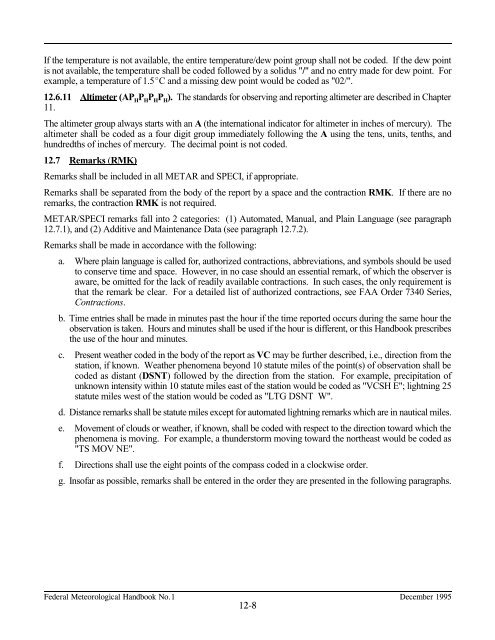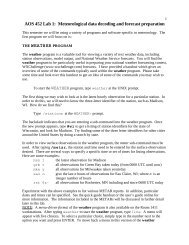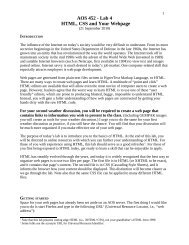Federal Meteorological Handbook No. 1 - Marrella
Federal Meteorological Handbook No. 1 - Marrella
Federal Meteorological Handbook No. 1 - Marrella
Create successful ePaper yourself
Turn your PDF publications into a flip-book with our unique Google optimized e-Paper software.
If the temperature is not available, the entire temperature/dew point group shall not be coded. If the dew point<br />
is not available, the temperature shall be coded followed by a solidus "/" and no entry made for dew point. For<br />
example, a temperature of 1.5�C and a missing dew point would be coded as "02/".<br />
12.6.11 Altimeter (APPPP). The standards for observing and reporting altimeter are described in Chapter<br />
H H H H<br />
11.<br />
The altimeter group always starts with an A (the international indicator for altimeter in inches of mercury). The<br />
altimeter shall be coded as a four digit group immediately following the A using the tens, units, tenths, and<br />
hundredths of inches of mercury. The decimal point is not coded.<br />
12.7 Remarks (RMK)<br />
Remarks shall be included in all METAR and SPECI, if appropriate.<br />
Remarks shall be separated from the body of the report by a space and the contraction RMK. If there are no<br />
remarks, the contraction RMK is not required.<br />
METAR/SPECI remarks fall into 2 categories: (1) Automated, Manual, and Plain Language (see paragraph<br />
12.7.1), and (2) Additive and Maintenance Data (see paragraph 12.7.2).<br />
Remarks shall be made in accordance with the following:<br />
a. Where plain language is called for, authorized contractions, abbreviations, and symbols should be used<br />
to conserve time and space. However, in no case should an essential remark, of which the observer is<br />
aware, be omitted for the lack of readily available contractions. In such cases, the only requirement is<br />
that the remark be clear. For a detailed list of authorized contractions, see FAA Order 7340 Series,<br />
Contractions.<br />
b. Time entries shall be made in minutes past the hour if the time reported occurs during the same hour the<br />
observation is taken. Hours and minutes shall be used if the hour is different, or this <strong>Handbook</strong> prescribes<br />
the use of the hour and minutes.<br />
c. Present weather coded in the body of the report as VC may be further described, i.e., direction from the<br />
station, if known. Weather phenomena beyond 10 statute miles of the point(s) of observation shall be<br />
coded as distant (DSNT) followed by the direction from the station. For example, precipitation of<br />
unknown intensity within 10 statute miles east of the station would be coded as "VCSH E"; lightning 25<br />
statute miles west of the station would be coded as "LTG DSNT W".<br />
d. Distance remarks shall be statute miles except for automated lightning remarks which are in nautical miles.<br />
e. Movement of clouds or weather, if known, shall be coded with respect to the direction toward which the<br />
phenomena is moving. For example, a thunderstorm moving toward the northeast would be coded as<br />
"TS MOV NE".<br />
f. Directions shall use the eight points of the compass coded in a clockwise order.<br />
g. Insofar as possible, remarks shall be entered in the order they are presented in the following paragraphs.<br />
������������������������������������ �������������<br />
����





